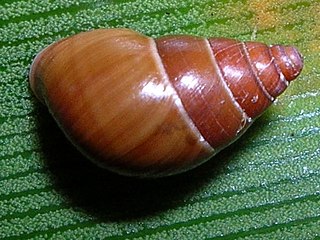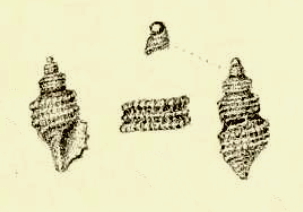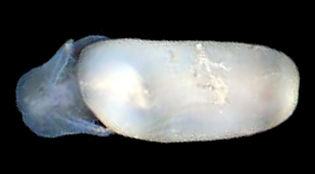Diaphanidae is a taxonomic family of small sea snails, marine opisthobranch gastropod molluscs or micromollusks in the superfamily Diaphanoidea, the headshield slugs and bubble snails.

Auriculella is a genus of air-breathing tropical land snails, terrestrial pulmonate gastropod mollusks in the family Achatinellidae. They are endemic to Hawaii and several species are extinct. They are oviparous and hermaphroditic. Among achatinellid snails, they are unique in the fact that they are not restricted to living on plants endemic to the Hawaiian islands. They have been known to relatively thrive on non-native plants such as ginger and night jasmine.
Nepotilla diaphana, common name the transparent false-turrid, is a species of sea snail, a marine gastropod mollusk in the family Raphitomidae.
Pleurotomella minuta is a species of sea snail, a marine gastropod mollusk in the family Raphitomidae.

Nepotilla is a genus of sea snails, marine gastropod mollusks in the family Raphitomidae.

Retusa is a genus of very small head-shield sea snails or barrel-bubble snails, marine gastropod mollusks in the family Retusidae.
Nymphicula adelphalis is a moth in the family Crambidae. It was described by David John Lawrence Agassiz in 2014. It is found in Australia, where it has been recorded from the Northern Territory.
Nymphicula cheesmanae is a moth in the family Crambidae. It was described by David John Lawrence Agassiz in 2014. It is found on the New Hebrides.
Nymphicula michaeli is a moth in the family Crambidae. It was described by David John Lawrence Agassiz in 2014. It is found in Papua New Guinea.
Nymphicula monticola is a moth in the family Crambidae. It was described by David John Lawrence Agassiz in 2014. It is found in the highlands of New Guinea.
Nymphicula insulalis is a moth in the family Crambidae. It was described by David John Lawrence Agassiz in 2014. It is found in New Caledonia east of Australia.
Nymphicula torresalis is a moth in the family Crambidae. It was described by David John Lawrence Agassiz in 2014. It is found in Papua New Guinea and Australia, where it has been recorded from Queensland.

Pachycondyla parvula is an extinct species of ant in the formicid subfamily Ponerinae described by from a fossil found in Europe. P. parvula is one of six Lutetian Pachycondyla species.
Utivarachna is a genus of Asian araneomorph spiders in the family Trachelidae first described by Kyukichi Kishida in 1940. It was largely ignored until Christa L. Deeleman-Reinhold revised the sac and ground spiders in 2001, transferring some species from Trachelas and adding several new ones. The genus was further expanded in 2014 and 2015.
Utivarachna arcuata is a species of spiders in the family Trachelidae found only in Yunnan Province of China. It was described in 2014 by Li Zhao and Xian-Jin Peng. Adult males reach 3.65 millimetres (0.144 in) to 5.1 millimetres (0.20 in) long, while females can be 5.85 millimetres (0.230 in) to 6.65 millimetres (0.262 in) long. It closely resembles the Thailand species Utivarachna rama, but there are several distinct differences. The back part of the palpal bulb is semi-spherical, the tip of the embolus is only about a fifth as long as the basal part, the tibial apophysis is slightly tapered, the copulatory opening is on the back of the epigyne, the back bursae are longer and thinner, and the connecting ducts are spaced farther apart. In Latin, the term "arcuata" means "curved". This name refers to the curved shape of the bottom part of embolus, the small, thin extension on the palpal bulb of the pedipalp.

Argyra diaphana is a species of fly in the family Dolichopodidae. It is distributed in Europe, except for the south.

Zeugomantispa minuta, the green mantisfly, is a species of mantidfly in the family Mantispidae. It is found in the Caribbean Sea, Central America, North America, and South America.
Diaphana is a genus of gastropods belonging to the family Diaphanidae.

Rissoella diaphana is a species of gastropod belonging to the family Rissoellidae.

Exaiptasia diaphana, the pale anemone, is a species from the genus Exaiptasia.








